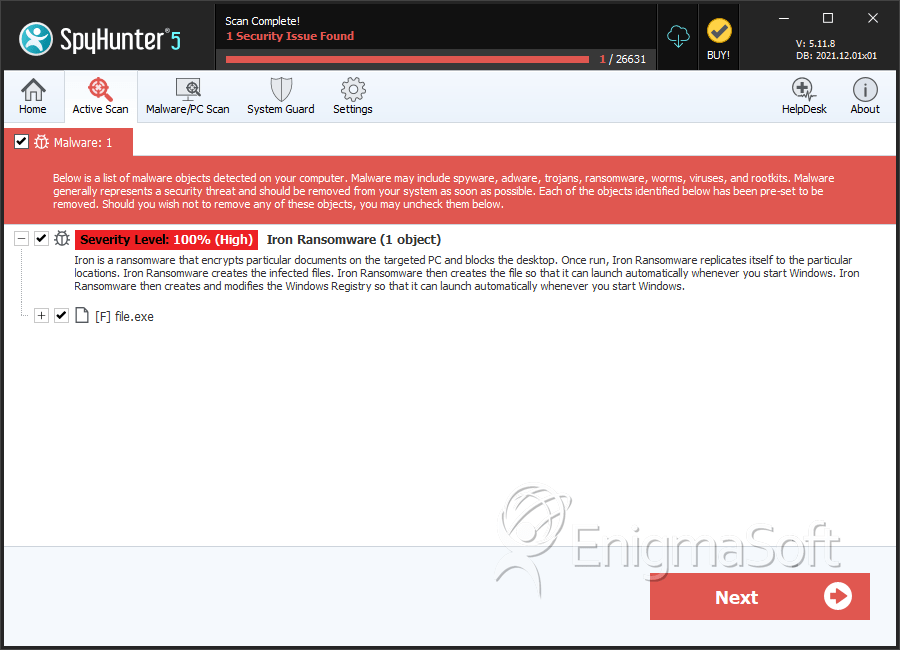Iron Ransomware
Threat Scorecard
EnigmaSoft Threat Scorecard
EnigmaSoft Threat Scorecards are assessment reports for different malware threats which have been collected and analyzed by our research team. EnigmaSoft Threat Scorecards evaluate and rank threats using several metrics including real-world and potential risk factors, trends, frequency, prevalence, and persistence. EnigmaSoft Threat Scorecards are updated regularly based on our research data and metrics and are useful for a wide range of computer users, from end users seeking solutions to remove malware from their systems to security experts analyzing threats.
EnigmaSoft Threat Scorecards display a variety of useful information, including:
Ranking: The ranking of a particular threat in EnigmaSoft’s Threat Database.
Severity Level: The determined severity level of an object, represented numerically, based on our risk modeling process and research, as explained in our Threat Assessment Criteria.
Infected Computers: The number of confirmed and suspected cases of a particular threat detected on infected computers as reported by SpyHunter.
See also Threat Assessment Criteria.
| Threat Level: | 100 % (High) |
| Infected Computers: | 5 |
| First Seen: | April 17, 2018 |
| Last Seen: | March 1, 2023 |
| OS(es) Affected: | Windows |
PC security researchers first observed the Iron Ransomware, an encryption ransomware Trojan, on April 11, 2018. The most common way of delivering the Iron Ransomware is through the use of corrupted spam email attachments. These spam emails may contain an attachment in the form of a Microsoft Word file with embedded macros that download and install the Iron Ransomware onto the victim's computer. The Iron Ransomware belongs to a family of threats that has released several variants recently, such as ransomware Trojans dubbed as 'Maktub'' and 'Satan'.
Table of Contents
The Iron Ransomware will Take the Victim’s Files Hostage
The Iron Ransomware runs as 'IronUnlocker.Exe' on infected computers. The Iron Ransomware, like the countless ransomware Trojans active nowadays, is designed to take the victim's files hostage, using a strong encryption algorithm that will make the victim's files inaccessible. The Iron Ransomware will encrypt 374 different types of files. The files favored by attacks like the Iron Ransomware include:
.3dm, .3g2, .3gp, .7zip, .aaf, .accdb, .aep, .aepx, .aet, .ai, .aif, .as, .as3, .asf, .asp, .asx, .avi, .bmp, .c, .class, .cpp, .cs, .csv, .dat, .db, .dbf, .doc, .docb, .docm, .docx, .dot, .dotm, .dotx, .dwg, .dxf, .efx, .eps, .fla, .flv, .gif, .h, .idml, .iff, .indb, .indd, .indl, .indt, .inx, .jar, .java, .jpeg, .jpg, .js, .m3u, .m3u8, .m4u, .max, .mdb, .mid, .mkv, .mov, .mp3, .mp4, .mpa, .mpeg, .mpg, .msg, .pdb, .pdf, .php, .plb, .pmd, .png, .pot, .potm, .potx, .ppam, .ppj, .pps, .ppsm, .ppsx, .ppt, .pptm, .pptx, .prel, .prproj, .ps, .psd, .py, .ra, .rar, .raw, .rb, .rtf, .sdf, .sdf, .ses, .sldm, .sldx, .sql, .svg, .swf, .tif, .txt, .vcf, .vob, .wav, .wma, .wmv, .wpd, .wps, .xla, .xlam, .xll, .xlm, .xls, .xlsb, .xlsm, .xlsx, .xlt, .xltm, .xltx, .xlw, .xml, .xqx, .xqx, .zip.
The Iron Ransomware will be used to carry out attacks on mid-sized businesses and servers, considering the sophistication of the Iron Ransomware, the resources behind the attack and its distribution campaign.
The Iron Ransomware’s Ransom Demand
The Iron Ransomware will drop a file on the infected computer named '!HELP_YOUR_FILES.HTML.' This file displays a message that reads as follows:
'Your documents, photos, database, and other essential files have been encrypted with the strongest encryption an unique key, generated for this computer. The private decryption key is stored on a secr4et Internet server, and nobody can decrypt your files until you pay and obtain the private key. The server will eliminate the key after a period specified in this window.'
The Iron Ransomware holds the victim's files and demands a ransom of 0.2 Bitcoin, which is approximately 1400 USD at the current exchange rate. The advice to infected computer users is to refrain from making contact with the people responsible for the Iron Ransomware attack. The odds are that these people will not help them restore their files, and even if they do, paying these ransoms allow the creators of the Iron Ransomware to continue creating and distributing threats like the Iron Ransomware to other computer users.
Protecting Your Data from Threats Like the Iron Ransomware
The best protection against threats like the Iron Ransomware is to have file backups on a cloud storage service or a portable memory drive. Unfortunately, since the Iron Ransomware uses a highly powerful encryption method, the best protection against the Iron Ransomware is to have preemptive backups of all of your files. An updated security program can remove the Iron Ransomware Trojan itself, but it will not restore the files corrupted by the attack, which corruption may be irreversible. Ransomware Trojans like the Iron Ransomware are becoming more common increasingly, and it is why computer users should ensure that their files are protected against these and other threats adequately. If enough computer users have file backups, then the people responsible for these attacks will not have a motive to still creating their threats.
SpyHunter Detects & Remove Iron Ransomware

File System Details
| # | File Name | MD5 |
Detections
Detections: The number of confirmed and suspected cases of a particular threat detected on
infected computers as reported by SpyHunter.
|
|---|---|---|---|
| 1. | file.exe | 1e60050db59e3d977d2a928fff3d34a6 | 2 |
| 2. | file.exe | c5337c6b345b0eea72e06d7ca93ab595 | 0 |

